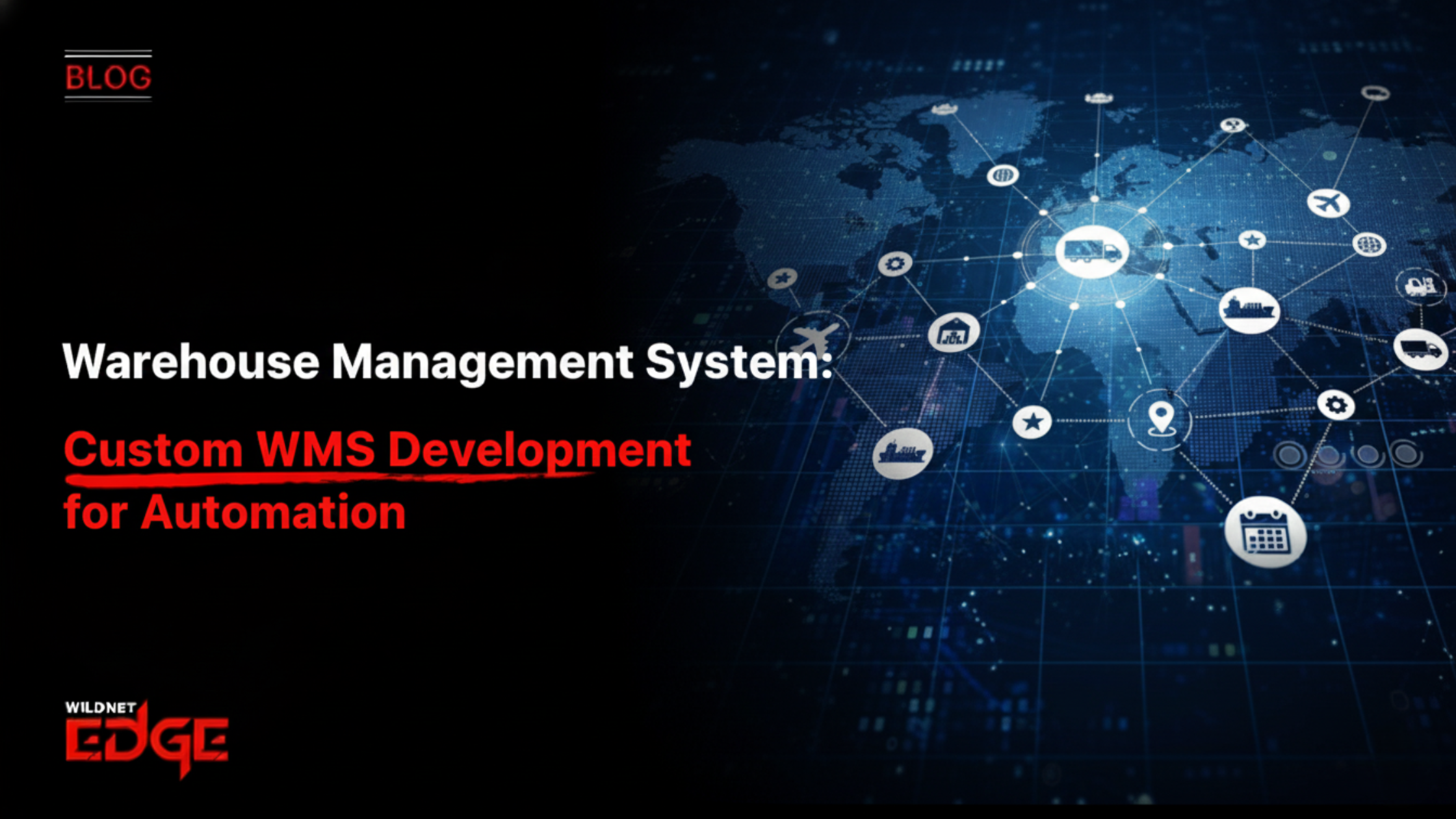Are you tired of dealing with inventory inaccuracies, delayed shipments, and operational chaos? If so, you’re not alone. Many businesses struggle to keep their warehouses running smoothly, and the solution often lies in a robust warehouse management system (WMS). In this blog, we’ll explore how custom WMS development can revolutionize your warehouse operations, streamline processes, and ultimately boost your bottom line.
Understanding WMS Software
A warehouse management system (WMS) is a crucial component of modern logistics and supply chain management. The primary purpose of WMS software is to optimize warehouse operations, ensuring that every aspect—from inventory tracking to order fulfillment—is executed efficiently.
Essential Features of WMS Software
- Inventory Tracking: Real-time visibility into stock levels helps reduce errors and improve accuracy. With features like barcode scanning and RFID technology, businesses can quickly locate items and manage inventory levels effectively.
- Order Fulfillment: WMS software automates the picking, packing, and shipping processes. This not only speeds up order processing but also minimizes the chances of human error, ensuring that customers receive the correct products on time.
- Labor Management: Effective labor management tools within WMS allow businesses to track employee performance, optimize labor allocation, and ensure that the right number of staff are available during peak times.
- Reporting and Analytics: Advanced reporting capabilities provide insights into inventory turnover, order accuracy, and other key performance indicators. This data is invaluable for making informed strategic decisions.
- Integration with Other Systems: A robust WMS can integrate seamlessly with other systems, such as Enterprise Resource Planning (ERP) and Customer Relationship Management (CRM) software, creating a cohesive ecosystem that enhances overall operational efficiency.
By leveraging these features, businesses can enhance their warehouse automation efforts and create a more streamlined operation.
Benefits of Inventory Automation
Inventory automation is a game-changer for warehouses looking to improve efficiency and accuracy. Here are some of the key benefits:
Enhanced Accuracy
Manual inventory management is prone to errors, leading to discrepancies that can disrupt operations. By automating inventory processes through WMS software, businesses can achieve a higher level of accuracy. Automated stock counting and tracking minimize the risk of human error, ensuring that inventory levels are always up-to-date.
Reduced Labor Costs
Labor costs can be a significant expense for warehouses. By implementing inventory automation, businesses can reduce the need for manual labor in inventory management tasks. Automated systems handle repetitive tasks, allowing employees to focus on more strategic activities that require human intervention.
Improved Efficiency
With automated inventory management, warehouses can streamline their operations. Processes such as stock replenishment, order picking, and shipping can be executed faster and with greater precision. This results in shorter lead times and improved customer satisfaction, as orders are fulfilled more quickly and accurately.
Better Space Utilization
Inventory automation helps optimize the use of warehouse space. Automated systems can analyze inventory levels and suggest optimal storage solutions, ensuring that products are stored in the most efficient manner. This not only maximizes space but also enhances accessibility to high-demand items.
Real-Time Visibility
One of the major advantages of inventory automation is real-time visibility into stock levels. Businesses can monitor inventory in real-time, enabling them to make data-driven decisions. This is particularly useful for managing seasonal fluctuations in demand, ensuring that businesses are always prepared to meet customer needs.
In summary, inventory automation through a custom warehouse management system can lead to significant improvements in accuracy, efficiency, and cost-effectiveness.
Custom WMS Development Process
Developing a custom warehouse management system involves several key steps that ensure the final product meets the specific needs of your business. Here’s a breakdown of the process:
1. Initial Consultation
The first step in custom WMS development is to conduct an initial consultation with stakeholders. This involves gathering requirements, understanding existing processes, and identifying pain points. The goal is to have a clear understanding of what the WMS needs to achieve.
2. Requirement Analysis
Once the initial consultation is complete, the next step is to analyze the requirements in detail. This includes defining the necessary features, functionalities, and integrations that the WMS will need to support. This phase is crucial for ensuring that the final product aligns with business objectives.
3. Design and Prototyping
With the requirements defined, the development team will create a design for the WMS. This includes wireframes and prototypes that illustrate the user interface and overall system architecture. Stakeholders will have the opportunity to provide feedback and make adjustments before development begins.
4. Development and Testing
During this phase, the actual coding of the WMS takes place. Developers will build the system according to the specifications outlined in the design phase. Continuous testing is conducted to identify and fix any bugs or issues, ensuring a smooth user experience.
5. Deployment
Once the system has been thoroughly tested, it’s time for deployment. This involves installing the WMS in the production environment and ensuring that all components are functioning as expected. User training is also conducted during this phase to ensure staff are comfortable using the new system.
6. Ongoing Support and Maintenance
After deployment, ongoing support and maintenance are crucial to ensure the WMS continues to operate effectively. This includes regular updates, troubleshooting, and enhancements based on user feedback. A reliable support system helps businesses adapt to changing needs and technology advancements.
By following this structured approach to custom WMS development, businesses can ensure that their warehouse management system is tailored to their specific needs, enhancing operational efficiency and scalability.
Future Trends in Warehouse Automation
As technology continues to evolve, so too do the capabilities of warehouse management systems. Here are some emerging trends that are shaping the future of warehouse automation:
AI Integration
Artificial Intelligence (AI) is becoming increasingly integrated into WMS software. AI can analyze vast amounts of data to optimize inventory management, predict demand fluctuations, and improve order fulfillment processes. This not only enhances efficiency but also enables businesses to make more informed decisions.
Robotics
The use of robotics in warehouse operations is on the rise. Automated guided vehicles (AGVs) and robotic picking systems can significantly speed up processes such as order picking and packing. This not only improves efficiency but also reduces the risk of workplace injuries associated with manual handling.
Real-Time Data Analytics
Real-time data analytics is transforming how warehouses operate. With the ability to analyze data as it comes in, businesses can make immediate adjustments to inventory levels, staffing, and logistics. This responsiveness is crucial for adapting to market changes and customer demands.
Internet of Things (IoT)
The Internet of Things (IoT) is revolutionizing warehouse management by enabling devices to communicate and share data. IoT sensors can monitor inventory levels, environmental conditions, and equipment performance in real-time. This data can be leveraged to enhance decision-making and improve operational efficiency.
Sustainability Initiatives
As businesses become more environmentally conscious, sustainability initiatives are gaining traction in warehouse operations. This includes optimizing energy use, reducing waste, and implementing eco-friendly practices. A custom WMS can help track and manage these initiatives effectively.
In conclusion, staying ahead of these trends can provide businesses with a competitive edge, allowing them to enhance their warehouse operations and improve overall efficiency.
Conclusion
In summary, investing in a warehouse management system tailored to your business needs can significantly improve your warehouse operations. By embracing custom WMS development and leveraging inventory automation, you can enhance accuracy, reduce costs, and streamline processes. With the expertise of WildnetEdge, you can ensure that your custom WMS development is not only effective but also scalable for future growth. Ready to take your warehouse to the next level? Contact us today!
FAQs
Q1: What is a warehouse management system (WMS)?
A warehouse management system (WMS) is software designed to optimize warehouse operations, including inventory tracking, order fulfillment, and shipping management.
Q2: How does WMS software improve efficiency?
WMS software automates key processes, reduces manual errors, and provides real-time visibility into inventory levels, leading to improved operational efficiency.
Q3: What are the key features of inventory automation in WMS?
Key features include barcode scanning, automated stock replenishment, real-time inventory tracking, and integration with other supply chain systems.
Q4: Can custom WMS development be tailored to specific industry needs?
Yes, custom WMS development can be tailored to meet the unique requirements of various industries, ensuring optimal performance and efficiency.
Q5: What are the costs associated with implementing a warehouse management system?
Costs can vary widely depending on the complexity of the system, customization needs, and the scale of your operations.

Nitin Agarwal is a veteran in custom software development. He is fascinated by how software can turn ideas into real-world solutions. With extensive experience designing scalable and efficient systems, he focuses on creating software that delivers tangible results. Nitin enjoys exploring emerging technologies, taking on challenging projects, and mentoring teams to bring ideas to life. He believes that good software is not just about code; it’s about understanding problems and creating value for users. For him, great software combines thoughtful design, clever engineering, and a clear understanding of the problems it’s meant to solve.
 sales@wildnetedge.com
sales@wildnetedge.com +1 (212) 901 8616
+1 (212) 901 8616 +1 (437) 225-7733
+1 (437) 225-7733































